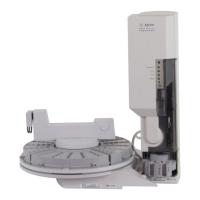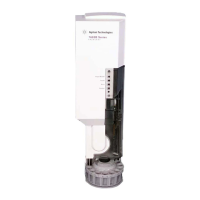232
Agilent 7820 GC Service
Intermediate positions of the rotor may result in
an interrupted flow path which could cause damage
to the valve or other components in the
chromatograph.
Valve rotors
Rotor type can be identified by color:
An off-white rotor is made of a PTFE composite and may be
used from room temperature to 200°C.
A black rotor is made of polyimide and may be used from
100 to 350°C.
The life of a valve is shortened if used outside
its specified temperature range. Do not mix rotor
types in the same system.
The rotor seats on a highly polished conical surface. When
properly seated, the polished surface prevents leakage around
the rotor and between non-selected ports. The finish precludes
adsorption of most GC samples.
The rotor assembly is a one-piece part with an integral molded
and machined conical hub and the parts necessary for proper
seating. The sample contacts only the PTFE composite (low
temperature) or polyimide (high temperature) as well as the
stainless steel of the valve.
Grooves in the rotor surface form the paths between specific
ports. The index pin prevents rotation beyond either stop of the
index lip. Valve ports are connected by the grooves only when
the index pin is close to or against either stop. Intermediate
positions result in flow shutoff through the valve and possible
damage if left in this position.
Preload assembly (not shown)
This assembly consists of a body, a spring, and an adjusting nut.
It holds the rotor in the valve body.
